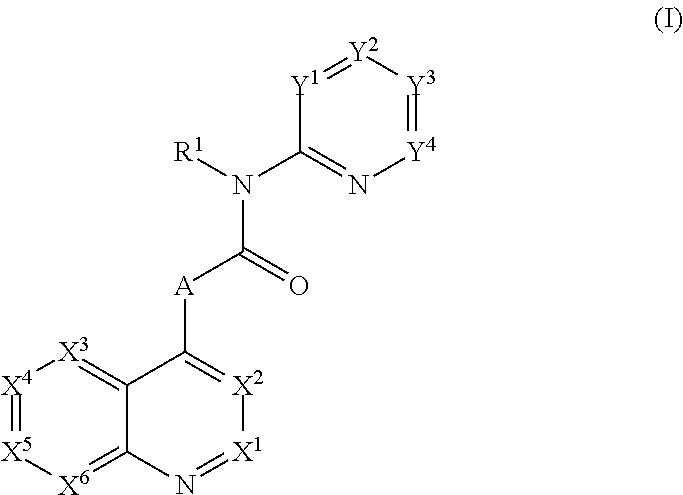Heterocyclic compounds and their use as glycogen synthase kinase-3 inhibitors
a glycogen synthase and glycogen technology, applied in heterocyclic compound active ingredients, biocide, drug compositions, etc., can solve the problems of neurotrophic activity, pharmacological gsk-3 inhibitors are not able to selectively inhibit one of the isoforms, etc., and achieve the effect of prevention and/or treatmen
- Summary
- Abstract
- Description
- Claims
- Application Information
AI Technical Summary
Benefits of technology
Problems solved by technology
Method used
Image
Examples
examples
[0288]The compounds were either characterized via proton-NMR in d6-dimethylsulfoxide or d-chloroform on a 400 MHz or 500 MHz NMR instrument (Bruker AVANCE), or by mass spectrometry, generally recorded via HPLC-MS in a fast gradient on C18-material (electrospray-ionisation (ESI) mode), or melting point.
[0289]The magnetic nuclear resonance spectral properties (NMR) refer to the chemical shifts (δ) expressed in parts per million (ppm). The relative area of the shifts in the 1H-NMR spectrum corresponds to the number of hydrogen atoms for a particular functional type in the molecule. The nature of the shift, as regards multiplicity, is indicated as singlet (s), broad singlet (s. br.), doublet (d), broad doublet (d br.), triplet (t), broad triplet (t br.), quartet (q), quintet (quint.) and multiplet (m).
Abbreviations:
DCM dichloromethane
DMSO dimethylsulfoxide
MeOH methanol
AcOH acetic acid
quant. quantitative
preparation examples
I. Preparation Examples
Example 1
1-(6-(3,6-Dihydro-2H-pyran-4-yl)pyridin-2-yl)-3-(8-fluoroquinolin-4-yl)urea
[0290]
[0291]1-(8-Fluoroquinolin-4-yl)-3-(6-iodopyridin-2-yl)urea (250 mg, 0.582 mmol), 2-(3,6-dihydro-2H-pyran-4-yl)-4,4,5,5-tetramethyl-1,3,2-dioxaborolane (187 mg, 0.873 mmol), sodium carbonate solution (2M, 1.31 mL, 2.62 mmol) and tetrakis(triphenylphosphine)-palladium(0) (68 mg, 0.058 mmol) were dissolved in 5 ml of DMF under an argon atmosphere and the mixture was stirred at 80° C., in a microwave oven, for one hour. After the solvent had been evaporated down to dryness, the resulting residue was treated with water and the mixture was then extracted with ethyl acetate. After the combined organic phases had been dried over sodium sulfate and the solvent had been filtered and evaporated down to dryness, the resulting residue was purified by column chromatography to give the title product (50 mg, 19%).
[0292]1H-NMR (d6-DMSO, 400 MHz) δ 3.32 (m, 5H), 3.95 (s, 2H), 4.21 (s, 2H),...
example 2
1-(8-Fluoroquinolin-4-yl)-3-(6-(tetrahydro-2H-pyran-4-yl)pyridin-2-yl)urea
[0293]
[0294]A solution of (1-(6-(3,6-dihydro-2H-pyran-4-yl)pyridin-2-yl)-3-(8-fluoroquinolin-4-yl)urea (21 mg, 0.058 mmol) and 12.3 mg of palladium on charcoal in 20 mL of methanol together with 1 mL of DMF and 1 drop of AcOH was stirred under 1 atm of hydrogen for 18 h. Filtration and evaporation to dryness afforded 21 mg (99%) of the desired title product.
[0295]1H-NMR (d6-DMSO, 400 MHz) δ 1.15 (m, 2H), 1.78 (m, 4H), 2.95 (m, 1H), 3.95 (d, 2H), 6.97 (d, 1H), 7.48 (br s, 1H), 7.65 (m, 2H), 7.75 (t, 1H), 8.08 (m, 1H), 8.35 (d, 1H), 9.82 (m, 1H), 10.11 (s, 1H); MS (APCI+) m / z 367.1 (M+H+, 100%).
PUM
 Login to View More
Login to View More Abstract
Description
Claims
Application Information
 Login to View More
Login to View More - R&D
- Intellectual Property
- Life Sciences
- Materials
- Tech Scout
- Unparalleled Data Quality
- Higher Quality Content
- 60% Fewer Hallucinations
Browse by: Latest US Patents, China's latest patents, Technical Efficacy Thesaurus, Application Domain, Technology Topic, Popular Technical Reports.
© 2025 PatSnap. All rights reserved.Legal|Privacy policy|Modern Slavery Act Transparency Statement|Sitemap|About US| Contact US: help@patsnap.com



